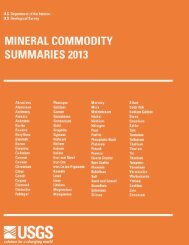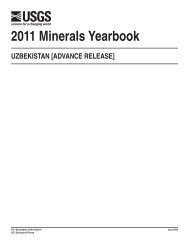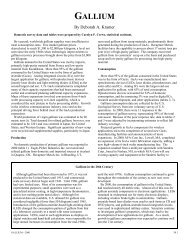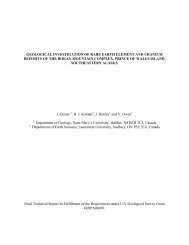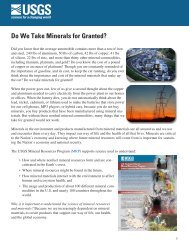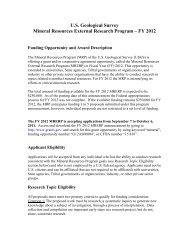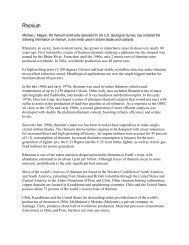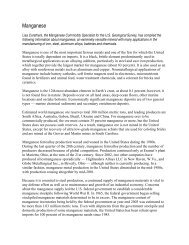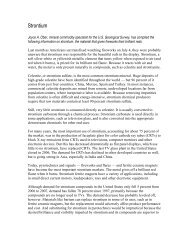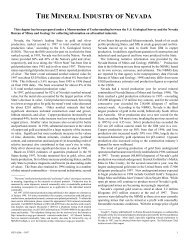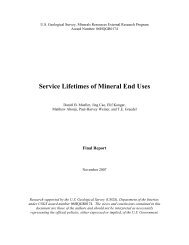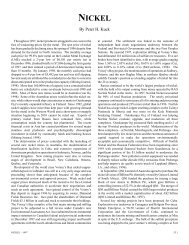Mineral Commodity Summaries 2003 - Mineral Resources Program ...
Mineral Commodity Summaries 2003 - Mineral Resources Program ...
Mineral Commodity Summaries 2003 - Mineral Resources Program ...
You also want an ePaper? Increase the reach of your titles
YUMPU automatically turns print PDFs into web optimized ePapers that Google loves.
SELENIUM<br />
Events, Trends, and Issues: In 2002, domestic consumption of selenium decreased slightly when compared with<br />
that of 2001. The average annual global consumption of selenium over the past 4 years is estimated to have been<br />
about 1,900 tons per year. Production of selenium was expected to decrease in 2002 owing to the use of ores with<br />
lower selenium content, the use of solvent extraction instead of older slime-producing technology, and the closure of<br />
some copper operations. The price of selenium was nearly constant at $3.50-$4.00 per pound for the first half of<br />
2002. Concern over supply caused the price to increase to $3.75-$4.25 per pound in the second half of the year.<br />
The use of selenium in glass remained strong. The use in copiers continued to decline, while the use in metallurgical<br />
additives increased. The use of selenium as an additive to no-lead, free-machining brasses for plumbing applications<br />
continued to increase as more stringent regulations on lead in drinking water were met (ordinary free-machining brass<br />
contains up to 7% lead). Alloys with bismuth/selenium additions are dominating this market. Selenium also reduces<br />
the quantity of bismuth needed, without adverse effects on alloy properties.<br />
Research continued to confirm the effectiveness of dietary selenium supplementation for human cancer prevention,<br />
and the use of selenium supplements in the plant-animal-human food chain increased. However, even if proven safe<br />
and effective, the dosage requirement for direct human consumption would be small, 200 to 400 micrograms per day<br />
per person; consequently, selenium demand would not change dramatically. Increased supplementation of fertilizer<br />
could be another way to achieve this public health benefit. Selenium already is added to fertilizer used to improve feed<br />
for livestock.<br />
World Refinery Production, Reserves, and Reserve Base: Reserves and reserve base estimates for Chile, Peru,<br />
and Zambia have been increased base on new information from those countries.<br />
Refinery production Reserves 4<br />
Reserve base 4<br />
2001 2002 e<br />
United States W W 10,000 19,000<br />
Belgium 200 200 — —<br />
Canada 350 360 6,400 15,000<br />
Chile 45 45 16,000 37,000<br />
Finland 25 25 — —<br />
Germany 100 100 — —<br />
Japan 739 650 — —<br />
Peru 23 25 5,400 9,300<br />
Philippines 40 40 2,000 3,000<br />
Sweden 20 20 — —<br />
Yugoslavia 20 20 1,000 2,000<br />
Zambia 9 10 3,500 6,500<br />
Other countries 5<br />
9 10 42,000 90,000<br />
World total (rounded)<br />
6<br />
1,580<br />
6<br />
1,460 84,000 180,000<br />
World <strong>Resources</strong>: In addition to the reserve base of selenium, which is contained in identified economic copper<br />
deposits, 2.5 times this quantity of selenium was estimated to exist in copper or other metal deposits that were<br />
undeveloped, of uneconomic grade, or as yet undiscovered. Coal contains an average of 1.5 parts per million of<br />
selenium, which is about 80 times the average for copper deposits, but recovery of selenium from coal appears<br />
unlikely in the foreseeable future.<br />
Substitutes: High-purity silicon has replaced selenium in high-voltage rectifiers and is the major substitute for<br />
selenium in low- and medium-voltage rectifiers. Other inorganic semiconductor materials, such as silicon, cadmium,<br />
tellurium, gallium, and arsenic, as well as organic photoconductors, substitute for selenium in photoelectric<br />
applications. Other substitutes include cerium oxide in glass manufacturing; tellurium in pigment and rubber<br />
compounding; bismuth, lead, and tellurium in free-machining alloys; and bismuth and tellurium in lead-free brasses.<br />
e<br />
Estimated. NA Not available. W Withheld to avoid disclosing company proprietary data. — Zero.<br />
1<br />
Prepared by Henry E. Hilliard.<br />
2<br />
Defined as reported shipments + imports of selenium metal - estimated exports of selenium metal, excluding scrap.<br />
3<br />
Defined as imports - exports + adjustments for Government and industry stock changes.<br />
4<br />
See Appendix C for definitions.<br />
5<br />
In addition to the countries listed, Australia, China, India, Kazakhstan, Russia, the United Kingdom, and Zimbabwe are known to produce refined<br />
selenium.<br />
6 Excludes U.S. production.<br />
149<br />
U.S. Geological Survey, <strong>Mineral</strong> <strong>Commodity</strong> <strong>Summaries</strong>, January <strong>2003</strong>



